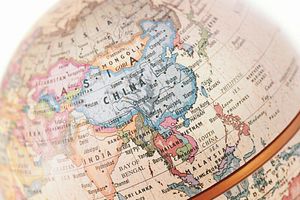Ever since the Asian Infrastructure Investment Bank (AIIB) opened its doors for business in January, there has been little released publicly about its prospective first loans or projects–until now. The Financial Times, citing sources with knowledge of the AIIB’s pending projects and tenders, reports that the AIIB will be sponsoring inaugural projects in Pakistan, Tajikistan, Uzbekistan, and Kazakhstan. Specifically, the bank will finance a highway in Pakistan, an expressway connecting Dushanbe, the Tajik capital, to the Uzbek border, and a peripheral ring road for the city of Almaty in Kazakhstan.
All four countries are member states that generally hew close to China geopolitically. (Pakistan is one of China’s closest Asian partners.) Moreover, all four states are members of the Shanghai Cooperation Organization. (Pakistan’s SCO membership is approved and is pending completion this year.) Despite the geopolitical affinities between China, the progenitor of the AIIB project, the bank’s Articles of Agreement state that AIIB loans are doled out based solely on the economic considerations of the project. Specifically, the bank aims to set aside “the political character of the member concerned.”
Assuaging concerns that these projects reflect Chinese geopolitical priorities in line with the One Belt, One Road initiative to expand infrastructure and connectivity to China’s west, these initial projects feature AIIB financing complementing and coordinating with other development banks.
For example, the Financial Times adds that in Pakistan, “the AIIB will join the ADB (Asian Development Bank) and DFID (UK Department for International Development) in funding a 64 km stretch of motorway connecting Shorkot to Khanewal, according to a tender document.”
Interestingly, in Pakistan, the ADB modified the terms of the project to allow AIIB participation. The FT cites a tender document for the project that notes that the “ADB is the lead financing partner for the project and administers it on behalf of the other co-financiers,” and that “bidding shall be carried out in accordance with ADB’s procurement guidelines and procedures.”
In Tajikistan, similarly, the AIIB will work with the ADB and the European Bank for Reconstruction and Development (EBRD). The Kazakh project is in coordination with the World Bank and the EBRD. In all cases, the AIIB is complementing instead of supplanting the other banks.
The China-led institution spurred much commentary last year as it emerged as a potential competitor to the World Bank and Asian Development Bank. In particular, the United States’ trepidation over its Western European allies’ decisions to join the bank suggested a divide between Beijing and Washington over the AIIB’s governance standards. (The two countries have since moved beyond the initial disagreement.) In addition to U.S. and Japanese concerns over the bank’s governance standards, China’s effective veto power within the AIIB–a function of how the bank’s share structure translates into voting power–has been a source of concern.
Despite last year’s concern over the AIIB’s governance standards and attempts to portray the bank as China’s bid to set up a competing framework for global development finance, the AIIB’s initial projects appear to be strictly complementary to existing institutions. This could change with time and no doubt observers of the bank will scrutinize the choice of the initial projects. The AIIB expects to approve $1.2 billion in project financing this year and we’ll likely see several other projects announced before the end of the year.
































